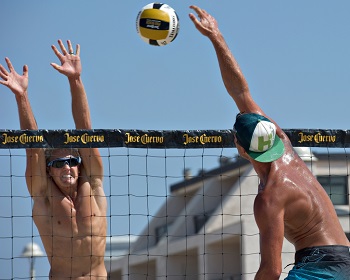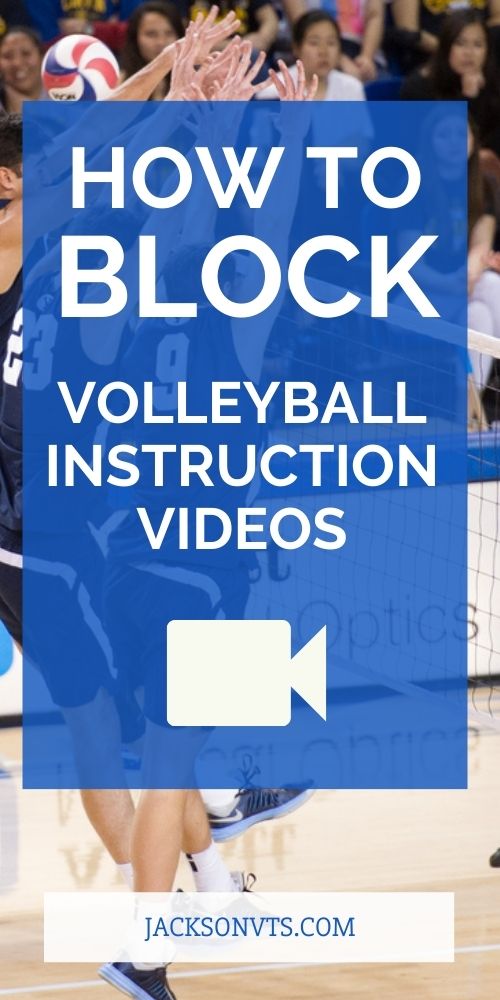Volleyball blocking how to, technique, and important keys to success.
How to Block in Volleyball
Techniques for blocking…
- Stand in a semi-flexed, stationary position.
- Hands are out in front of you with palms facing the net.
- Do a quarter squat jump as you time the attack.
- One of the most important aspects to blocking is hand positioning.
- Be sure to penetrate the net.
Penetrate means to get your hands onto the other side as far as possible. Penetration narrows the angles your opponent has to hit in. Penetrating might be the most important part of blocking. If all else fails, remember to penetrate.

Always remember to penetrate the net and take up a lot of “crossing space”
Keys to Hand Positioning
- Always penetrate the net. Penetration means reaching over the net. Not contacting the ball on the opponents side while blocking is the most common and critical error made by a blocker.
- Keep hands far apart while blocking. Most blocks should occur with only one hand or arm making contact with the ball. If you make contact with the ball by both hands, your hands are likely too close together. If the ball is hit between your hands or arms, this is referred to as a “good miss” because most beginners have trouble keeping the hands apart during volleyball blocking.
- Keep the fingers apart and strong. There should be space between your fingers while you block.
- Position your hands and arms so the ball will rebound into the court. You want to angle your hands so the ball will be deflected back into your opponents court.
- Most blocks should be made by the hands, not the arms. If you block the ball with your arms, you probably get tooled a lot. The best volleyball blocking skills involve the technique of penetrating the net, clamping down on the ball, and completing the block with the hands.
Key Points to Blocking
- Use consistent footwork and learn to time the attacker. You need to get good at reading the play that’s unfolding on the other side of the net. The better you are at reading the pass, reading the set, and reading the attacker, the better you’ll be at getting in position to block.
- Getting in the right blocking position is important. However, you also need to understand what good positioning is. Always penetrate the net and angle your hands into the court.
- Commit to what you are blocking and don’t reach. A common error is trying to react and reach for the ball. You don’t want to be reaching. You want to focus on blocking the crossing space. Great blockers don’t focus on reaching high to block. Great blockers focus on penetrating into the crossing space, extending over the net as far as possible.
- Know what area you are suppose to block. Are you suppose to block angle while your team covers line? Know what you’re suppose to block and commit to it.
Volleyball Blocking Swing Technique
Swing blocking is the technique of volleyball blocking by swinging the arms in an effort to jump higher to block.
This movement involves using the arms, hips, and shoulders to create more effort and force for jumping up to block.
A swing block is like an “approach” for blocking
The swing block is much like the approach prior to spiking. For example, the blocker will take a certain amount of steps to get in position to block. Basically, the blocker is approaching to block.
The swing block just like any other skill in volleyball should be used appropriately. A team likely shouldn’t swing block in every situation.
For example, there are times when a swing block won’t be effective against a first tempo attack. A team that runs a fast offense will be very difficult to swing block against. Always remember that there will be times that it’s better to use conventional blocking methods.
If you enjoyed these tips and would like to keep it close to you at any time, just save this pin to your Pinterest Volleyball Board.

Home › How to Play › Blocking
